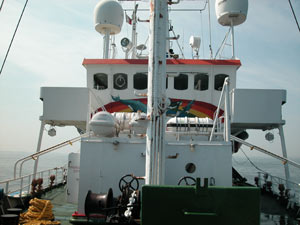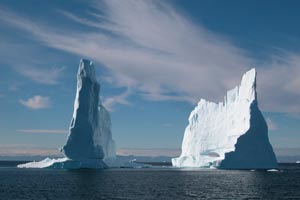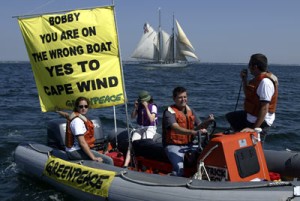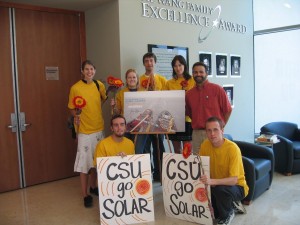September 15, Boston

From Eric: When I close my eyes I can still see ice bergs - towering, massive chunks of glacier floating in the sea. The images of Greenland are strong in my mind despite the hot September air. After nearly a month touring Greenland and Canada, I am almost back in the U.S. I am excited about this next leg of my journey and looking forward to talking with people about some of the things I have seen. Did you know that if the Greenland ice cap were to melt completely that sea levels would rise 7 meters? The sail on the Arctic Sunrise from Halifax to outside Boston (where we are currently anchored) was uneventful which, as I am learning, is how an ocean transit should be. I continue to learn new skills on board. I have also met a new batch of interesting people as new crew members joined in Halifax. Today, we were all treated to a series of whale sightings that awed everyone on board, even our sea-hardened captain.
From Lonnie: My trip to Cape Cod went well. I spoke at Cape Cod Community College about the Cape Wind Project and had a full house. Cape Cod Wind Farm is a project to install 130 energy efficient wind turbines in Nantucket Sound. The wind farm would provide 75% of the Cape and surrounding islands' energy and reduce the Cape's reliance on the dirty Canal power plant in Buzzards Bay, the third dirtiest plant on all the east coast.
September 7, St. Lawrence River

Lonnie writes: I spoke at Cape Cod Community College in Barnstable Sept. 6. While there I endorsed the proposed Cape Wind farm, a project to install 130 energy-efficient wind turbines in Nantucket Sound. On a more practical expedition note, I hope to start training again with the tires October 1 and also work full time in the office. Of course, there are more interesting activities in life, but pulling upwards of three tires at a time is an important aspect of our training.
Eric writes: Of course it's true about rolling stones, but ice-breaking ships, too? You bet, the Arctic Sunrise has been on the move throughout our Canadian tour and much too busy to gather moss. With stops at Quebec City, Three Rivers and Montreal, the ship has been a constant buzz of activity and activists (it's Greenpeace, of course).
In Montreal alone, nearly 2,400 people toured the ship. I also had a chance to meet many of the amazing Greenpeace Canada staff, who have proved to me all over again what it means to be passionate about the environment. While the Canadian government has ratified the Kyoto Protocol, the G.P. campaigners here feel that more action needs to be taken.
Our tour of eastern Canada has been especially interesting to me as I've had the opportunity to explore an area which was once a gateway for some of the earliest explorers of North America. Seeing monuments to these people, of whom I've only read, is humbling at best. I had to smile when I passed by the statue of Jacques Cartier, a distant relative of Lonnie's. I couldn't help but snap a few pictures and send them back to Grand Marais.
Ship life has been an adjustment for a landlubber like myself. Motorized vehicles, no matter the type, are not my first love. Regardless, being on the open ocean is an experience that I'll never ever forget - a wide horizon rolling into near infinity, a gentle breeze, birds, whales...
Equally amazing is my adjustment to this life. I found myself using the term aft to describe the back of the ship - a word which three weeks ago had never even passed my lips. I can flake the anchor chain and coil a heave line. I know where the cargo net, tag lines and paint are stored.
This life is steeped in history, too. Traveling by ship, I can't help but wonder if my thoughts are anything like those of the explorers before me. Sailing into unknown lands, missing their loved ones, scared and excited. What I once could only imagine, I now understand.
August 23, Labrador Sea

It's hard for me to imagine that little over two weeks ago I was still tucked snugly in the comfort and convenience of Grand Marais, Minn. Little did I know when I accepted Greenpeace's offer to join the Arctic Sunrise on the West coast of Greenland what I was in for.
After fumbling around with mariners' terms, walking down wrong stairways, wandering fore when I should have been aft and so on, I am beginning to learn my way around the Arctic Sunrise. It is an incredible ship with a more than capable crew. All are experienced veterans who make my experiences in life seem quite provincial. Most have traveled around the world several times over.
I have also had the opportunity to watch some of the unique research that has been going on here. Dr. Jason Box from Ohio State University and the Byrd Polar Research group have been measuring melt water pools on the surface of the Greenland ice sheet. Assisting Dr. Box on the ice cap was none other than OWE's Field Logistics Manager John Hoelscher. It was good to catch up with John, if ever so briefly as he has now left the ship and headed home.
After only a short glimpse (for me) of Greenland's beauty we are now leaving the West Coast and heading to Canada. We will eventually make our way to Quebec and Montreal to participate in 'open boats' organized by Greenpeace Canada, designed to bring more attention and action to global warming. In the meantime, we are making our way south, in what I have been told are relatively mild seas. Unfortunately, for a landlubber like myself, it's more like the Perfect Storm.
Meanwhile, Lonnie is busy in Grand Marais. Even in the middle of the ocean we manage to stay in e-mail contact. Lonnie recently returned from a trip to Washington D.C. where he gave a presentation to the Greenpeace staff and had meetings with some of our good friends there.
August 22, Washington DC

The Greenpeace ship Arctic Sunrise just completed its tour of Greenland, investigating and documenting the latest evidence of global warming. The Arctic Sunrise now travels to Canada to begin the third phase of Project Thin Ice-a tour down the East Coast of the United States. The purpose of this tour is highlighting solutions to global warming, namely the use of cleaner, climate-friendly forms of energy such as offshore wind. This photo is from a recent activity in Nantucket Sound, where Greenpeace is working and organizing in the Cape Cod area to promote the Cape Wind project, which would be the first offshore wind farm in the United States. Photo copyright Warshaw/Greenpeace.
Besides doing things like paint banners like the one in this photo, I've had the privilege this summer of working on arrangements for the U.S. East Coast ship tour. Greenpeace is holding "open boats" in Boston, New York City, and Miami in September and October as part of this tour. If you're in the area, be sure to stop by-it's a great opportunity to see a Greenpeace ship, meet the captain and crew, and learn more about what Greenpeace is doing to promote renewable energy use. Check out http://www.greenpeace.org/usa/about/ships/the-arctic-sunrise/come-onboard for exact locations and times.
As my time in Washington draws to a close, I am extremely impressed at the complex issues Greenpeace tackles with enormous dedication and energy. Project Thin Ice has been a major success thus far, first gaining worldwide attention for global warming through the One World Expedition, and then documenting the impacts of warming on the fragile Arctic region. The One World Expedition is fortunate to call Greenpeace its environmental partner. For more information on Project Thin Ice, go to www.projectthinice.org.
August 10, Amsterdam, Grand Marais, Greenland

The One World Team is spanning the globe to continue their commitment to global warming. Recently, Lonnie made a trip to Long Beach, California to support another campaign. The events were a huge success as the group influenced the CSU Trustees and Chancellor's Office to push their goals further in the direction of clean energy.
Meanwhile, Eric is Amsterdam on his way to Greenland and reports: Last week I was in Grand Marais and now I am on my way to Greenland to fill in as a deck hand on the Greenpeace ship Arctic Sunrise. I am excited beyond belief at the opportunity to continue the One World commitment to better understanding the effects of global warming as well as bearing witness to these changes.
And finally, John H. writes: Greetings from South West Greenland - after 6 weeks aboard the Arctic Sunrise we have turned the corner to the West Coast of Greenland. We entered the fjord systems to Narsaq, a town whose name means The Plain.
A small-scale hydro project is under construction just east of here that should free both Narsaq and nearby Qaqortoq from dirty, and expensive, diesel electricity generation. This will supply power to around 5,000 people. Qorlortorsuaq Hydro Energy plant utilizes water from high lakes fed from the icecap, as it plummets down toward the fjord below. The project consists of a small dam under construction just east of here that will produce 7.6 MW of power. Transmission lines will also have to be set up to then bring the power to the towns of Narsaq and Qaqortoq - hopefully allowing them to shut down their dirty diesel generators for good. This project has the other advantage of being able to produce energy at a much lower cost than diesel generation.
August 3, Arctic Ocean

Satellite data for the month of June show Arctic sea ice has shrunk to a record low, raising concerns about climate change, coastal erosion, and changes to wildlife patterns.
The National Snow and Ice Data Centre in the United States uses remote sensing imagery to survey ice cover at both poles.
The centre says 2002 was a record low year for sea ice cover in the Arctic, since satellite observations began in 1979. There's evidence that may have been the lowest coverage in a century.
Now scientists fear this year could be worse. June readings indicate the ice is at its lowest limit ever for that time of year.
"It actually melted back farther than normal pretty much everywhere around the Arctic," says Walt Meier of the National Snow and Ice Data Centre in the U.S.
"Where it's been retreating the most has been north of Alaska and north of eastern Siberia."
Meier says the amount of ice that covered the Arctic Ocean in the month of June this year shrunk by a record six percent below the average rate for the month.
July 26, Greenland

Dramatic discovery Confirms Scientists' Predictions of Accelerated Global Warming
East Coast Greenland - Independent scientists on board the Greenpeace ship Arctic Sunrise recently discovered that a Greenland glacier has accelerated in the past 9 years exceeding all expectations and has now become one of the fastest moving glaciers in the world. These observations validate predictions about impacts to Greenland glaciers from recent global warming.
Outlet glaciers like Kangerdlugssuaq transport ice from the heart of the Greenland Ice Sheet to the ocean and discharge icebergs, which contribute to sea level rise. Kangerdlugssuaq Glacier alone transports or "drains" four percent of the ice from the Greenland Ice Sheet, and so any changes in the speed of these glaciers holds tremendous significance in terms of sea level rise.
"This is a dramatic discovery," said Dr. Gordon Hamilton, who undertook the measurements on Kangerdlugssuaq Glacier on Greenland's east coast with University of Maine PhD student Leigh Stearns. "There is concern that the acceleration of this and similar glaciers and the associated discharge of ice is not described in current ice sheet models of the effects of climate change. These new results suggest that the loss of ice from the Greenland Ice Sheet, unless balanced by an equivalent increase in snowfall, could be larger and faster than previously estimated."
The Arctic Sunrise is in Greenland this summer documenting the signs and impacts of global warming in this part of the Arctic. The scientists from the Climate Change Institute at the University of Maine are conducting an independently-funded study into glacier variations as evidence of recent global warming.
